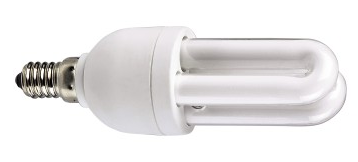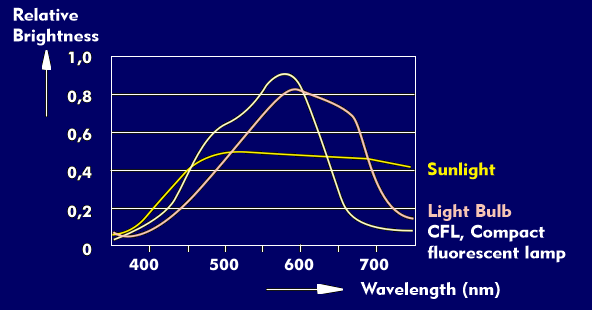compact fluorescent lamp (CFL)
As can be seen from the name energy-saving lamp, Compact Fluorescent Lamp (CFL), these lamps are characterized by low energy consumption, high efficiency, luminous efficacy of about 70 lm/W and a minimum service life of over 10,000 hours. They are compact fluorescent lamps with coiled or folded tube length and reduced tube diameter. This, together with miniaturized high- voltage electronics, has made it possible to reduce energy-saving lamps to the size of incandescent lamps.
In principle, the light in the energy-saving lamp, which belongs to the gas discharge lamps, is generated by an ionized gas column at low pressure. The electrons emitted from the electrodes by heat collide with the mercury atoms and emit energy as UV light. Ionization is maintained by the electric current supplied through two electrodes.
The inside of the glass body is coated with fluorescent phosphor, which is excited by the UV light and emits visible light. The color temperature of the visible light emission is determined by the mixture of fluorescent materials. The efficiency of energy-saving lamps increases significantly with frequency.
Voltages of about 1,000 volts are required to ignite the ionization. These are supplied by a ballast equipped with power semiconductors instead of chokes and bimetallic starters. During ionization, fluorescent tubes have a negative resistance, which is why the ballast is equipped with current limiters. In order to achieve full light output, the mercury present must first evaporate, this process takes about 60 to 80 seconds depending on the outside temperature.
In the classic energy-saving lamps operating with mains frequency, the ballast was relatively large. For this reason and because of the improvement in efficiency, the development went towards electronically controlled energy-saving lamps with a higher frequency. This development led to compact fluorescent lamps (CFL). Their efficiency is about four times that of incandescent lamps.
Electronically controlled energy-saving lamps operate with free-running oscillators whose signals are used as square-wave signals to control the switching transistors. The compact energy-saving lamps typically have E14 or E27 lamp bases and are thus compatible with incandescent lamps in terms of the socket.


